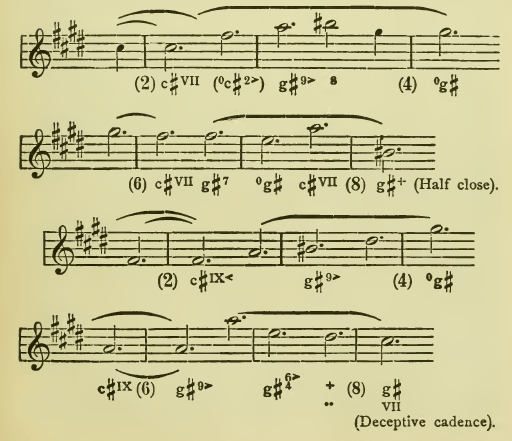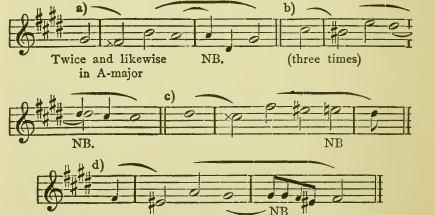Browse in the Library:
Or browse in the categories menus & download the Library Catalog PDF:
Bach: Prélude and Fugue IV BWV 849 WTC I (with sheet music, Noten)
Prélude IV from the Well Tempered Clavier I
Fugue IV from the Well Tempered Clavier I

Prélude and Fugue in C sharp minor BWV 849
Musical Analysis
The last three of the group of four preludes in advanced keys in W.F. Bach’s Clavier-Büchlein (C sharp, E flat and F minors) are of cantabile character, and are presumably meant for developing an expressive manner of playing after the earlier finger-exercise pieces. The C sharp minor prelude seems to build on the E major prelude (its relative major) in that the E major is an exercise in expressive melodic projection in a simple texture (one part in the right hand, two in the left).
The C sharp minor is more sophisticated in demanding as much expressive sensitivity but in a more complex texture, often of four parts with two parts in the right hand. Bach’s concern for expression and playability in this more complex texture is evident from the alterations to the detail of inner parts which he made in the later version, which allow a more natural shaping of the top part and also improve the profile of the inner parts.
In the prélude, the serious, sad key of C# minor expresses noble feeling, full of depth and energy. The two following groups each of two measures:


the first, the commencement of the fore-section (Vordersatz), the latter, that of the after-section (Nachsatz) in the first period, are Uke unto mighty gasps, or, better still, to the yearning sighs of a great heart. The piece is built up of five 8-measure periods (at times with considerable extensions) consisting of developments of the same. They are spun out in sequential form, so that the lines of the music often become quite immeasurable, as, for instance, in the second period,

but in a still stronger degree in the last two periods in which ebb and flow fill eight whole measures; the tempo must not however become very slow. Czerny’s Metronome marks

, with crotchets therefore as beats, is a decided mistake; it corresponds with his tempo indication Andante con moto instead of Andante con espressione or sostenuto, if indeed Adagio be not the only suitable one for it. The following may sound paradoxical, but really it is not so: the crotchets must be taken faster than Czerny wishes, (almost double as fast) in order to be able to follow the

as a count or beat. How would it be possible to grasp the gigantic lines of the last period of eight measures (before the corrected close of four measures).
With regard to the scheme of modulation, it may be briefly remarked, that the first period closes in the (parallel) key of E-major, but the 8th measure acquires the new meaning of 2nd in the following period, which comes to a marked close in G# minor (minor upper-dominant).
Here ends the first section. The third period passes through B-major (2nd measure), touching lightly on C#minor (4th measure), to F# minor (4a, in which an elision of an unaccented half measure occurs), and again settles
firmly in the key of C# minor.
With this, the piece is really at an end, for the periods which follow, and which by their marked shortenings (elision of the 1st and 5th measures), appear, in comparison with those of the first section, highly intensified; they modulate no more, but continue to form extended close-confirmations. The harmonic scheme is as follows:


The fugue (à 5) rises like unto a majestic cathedral, increasing in intensity up to the close; and finally, where the strettos of theme and countersubject form the highest point, and, at the same time, the real close (the rest is a coda with organ-point on the dominant, and assuredly a diminuendo was intended), the might is simply overwhelming.
The theme, evidently of allabreve character, as the merest glance will show, is one of the very shortest, and must be read:

As Bach repeatedly changes the closing (accented) semibreve into an unaccented one, minims, not semibreves, are, as a matter of fact, the real pulse throbs of the piece (certainly counts frequently changing meaning, i. e. accented becoming unaccented, would scarcely be intelligible; for, as is known, the elision of certain counts produces peculiarities of the most mischievous kind).
We must therefore say that within quiet minim measure the theme nevertheless proceeds with semibreve values, and therein lies its dignity (its dignity is more than great: it is colossal).
The theme is favorable to regular construction (four full measures); but only in the third section of the fugue does Bach bring the entries so close to one another, that each set of two forms a complete period of 8 measures:

The answer is a faithful transposition of the theme in the fifth; but it is worthy of note, that already in the first development there is an answer in the fourth (underdominant), and, indeed (if to the four regular voices we
suppose the addition of a second alto), in the first alto. This mode of answer does not, however, begin with the under-dominant, but, according to rule, with the fifth, and then proceeds to answering in the fourth; the end notes are, indeed, quite free:

The characteristic interval of the diminished fourth, extending from the sub-semitone to the third degree, has, however, been preserved. (This leads easily to whether, at the present day, when a knowledge of the nature of harmony and of logical tonal construction has been so powerfully developed, the fugue form actually need be limited to the reply in the fifth, or whether, as Bach has done here, a [tonal] answer on other degrees might not be attempted?)
In the further course of the fugue several other light deviations occur in the theme entries, among which the substitution of a perfect for the diminished fourth in the single major entry of the middle section {A-major, parallel of the under-dominant) almost explains itself; the others,
without exception, concern the end of the theme, viz.:

Next to the real theme, which, with exception to a few connecting bars, is never absent from the plan, two counter-subjects become of immense importance: there is first a succession of quavers of organ -like figuration, which IS prudently led up to by crotchets, thus marking the
beginning of the middle section,

and from thence onwards (appearing also in upward motion), it winds uninterruptedly through the voices like a garland, and only ceases at the coda. The same, although foreshadowed in the preceding second development, introduces a new, and somewhat impetuous character into the fugue, a strong contrast to the above-mentioned semibreve movement of the theme, and this character is still further intensified by addition of a formal second theme

(with occasional alteration of the cadence); it only forms a counterpoint to the second half of the theme, but is also employed in light imitation to fill up the short gaps between the theme entries. It is impossible to look upon this as a transformation of the first counterpoint to the Comes

on account of the totally different measure and build which it maintains throughout.
The combinations of the coda,

and

by continued imitations of the counter-theme (at the distance
of a minim), only once, and quite accidentally, introduce
the same in a position in which the feminine ending

which constitutes the only resemblance, is presented in the same position as in the first counterpoint to the Comes.
The principal sections of the fugue are:
I. The Exposition consisting of the first and second developments: the first concludes with a redundant entry of the Comes in the tenor in the minor key of the upper – dominant (G#minor). As Bach makes the tenor pause when the soprano enters (the five voices rise one above another, like the stories of a tower), the new entry of the tenor makes it seem as though the fifth voice was only now coming in (anyhow the five-part writing only now becomes an objective fact).
The second development (beginning with 3 voices) joins on immediately: the tenor continues at once with the theme in the under-dominant, whereupon the second alto follows with C# minor the bass with B major, and the first alto with E major. Both these developments occupy two eight-measure periods, with the already noted elisions.
II. The second section which now follows (with the running quaver passage) brings back the key of C# minor (tenor) with theme entries in G# minor (Comes, 2nd alto), again C# minor (1st alto) and F# minor (soprano, for the first time with the counter-theme, as conclusion of the first period of this section), once again F# minor (bass), and A-major (2nd alto), forming a new point of rest; but as the Dux is taken up by the 1st alto, the music continues without break.
It should be noted that the appearance of the principal key at a moment in the period having such little cadential power shows a striving towards, but not a full reaching of the same; after the previous sinking down to the under-dominant and to its parallel key, that could only be accomplished by a powerful turning in the direction of the upper -dominant.
Bach therefore lays hold of the dominant of the dominant (D#7, theme in the first alto), and returns from it to the first dominant (with the above noted chromatic progression), so that now (the 8th measure changing its meaning to that of 1st).
III. The concluding section can open effectively, but quietly (not, as Czerny will have it, ff as the culminating point of the whole, but mf) with the entry of the Dux in the lowest position (on great C).
The cadential meaning of this section reveals itself in unmistakable fashion, since soprano and tenor introduce the Dux in the principal key, and indeed with elision of the 5th and 1st measures, as at the commencement, and again (waiving the elision) the theme is given out in the under-dominant by the alto, and the Dux in still more impressive manner by the soprano, whereupon the coda, with its close strettos of theme and counter-theme unfolds, the utmost fullness and power, and opens up into an organ -point on G#, over which is heard once more the Dux in the soprano.
But under the closing C# oi the soprano, the first alto gives again the answer in the under -dominant, thus forming a plagal close. It would be difficult to name anything at all comparable to the majestic rising and falling from the low bass entry at the commencement of the third section down to the very last note!
Browse in the Library:
Or browse in the categories menus & download the Library Catalog PDF:
